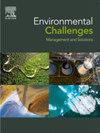Spatiotemporal analysis of thermal islands in a semi-arid city: A case study of Kermanshah, Iran using machine learning and remote sensing
Q2 Environmental Science
引用次数: 0
Abstract
Studying urban land use/land cover (LULC) and land surface temperature (LST), and assessing their changes, is crucial for understanding and mitigating the environmental and climatic impacts on cities in semi-arid regions, where water scarcity and heat stress exacerbate urban sustainability challenges. In this study, Landsat 8 data from 2013 to 2023 were used to assess changes in Kermanshah city. LST was extracted using a Mono-Window algorithm (MWA) for each year. Following Intensity-Hue-Saturation (IHS) pan-sharpening, LULCs were classified into five categories: built-up areas, vacant land, green spaces, water bodies, and transportation infrastructure, using training samples and machine learning methods. Cold Islands (CIs) and Hot Islands (HIs) were identified for each image using LST and Getis-Ord Gi analysis, and their spatio-temporal changes were evaluated with the Kappa index and landscape metrics. The sample size for assessing the impact of environmental parameters on LST variations was determined using the Cochran formula. Topographic, topoclimate, and biophysical variables, along with machine learning methods and the chi-square test, were employed to model and evaluate LST variation across different LULCs.
The results demonstrate a significant increase in HIs, particularly in the city's periphery, driven by rapid urbanization, impervious surface expansion, and reduced green cover. Key environmental factors, including elevation, built-up areas, and green space density, critically influenced LST variations. Although green spaces expanded in some areas, they were insufficient to counteract the intensifying HI effect. The analysis revealed a 65 % spatial consistency in HI patterns over the decade, highlighting persistent thermal hotspots.
The findings underscore the urgent need for sustainable urban planning, prioritizing green infrastructure and resilient design strategies to mitigate HI effects, reduce energy consumption, and improve urban livability. Future studies could focus on the impact of building heights and the expansion of urban green spaces on thermal islands.
半干旱城市热岛时空分析:基于机器学习和遥感的伊朗克尔曼沙阿为例
研究城市土地利用/土地覆盖(LULC)和地表温度(LST)并评估其变化,对于了解和减轻半干旱地区城市的环境和气候影响至关重要,在这些地区,水资源短缺和热应激加剧了城市可持续性挑战。本研究利用2013 - 2023年的Landsat 8数据对克尔曼沙阿市的变化进行了评估。利用单窗算法(Mono-Window algorithm, MWA)提取每年的地表温度。在强度-色调-饱和度(IHS)泛锐化之后,使用训练样本和机器学习方法将lulc分为五类:建成区、空地、绿地、水体和交通基础设施。利用地表温度(LST)和Getis-Ord Gi分析对各影像进行冷岛(CIs)和热岛(HIs)的识别,并利用Kappa指数和景观指标对其时空变化进行评价。评估环境参数对LST变化影响的样本量使用科克伦公式确定。利用地形、气候和生物物理变量,以及机器学习方法和卡方检验,对不同lulc的地表温度变化进行了建模和评估。结果表明,在快速城市化、不透水地表扩张和绿化减少的推动下,HIs显著增加,尤其是在城市外围。海拔、建成区和绿地密度等关键环境因子对地表温度变化具有重要影响。虽然一些地区的绿地面积有所扩大,但不足以抵消日益加剧的HI效应。分析显示,在过去十年中,HI模式的空间一致性为65%,突出了持续的热热点。研究结果强调了可持续城市规划的迫切需要,优先考虑绿色基础设施和弹性设计策略,以减轻HI影响,降低能源消耗,提高城市宜居性。未来的研究可以集中在建筑高度和城市绿地扩张对热岛的影响上。
本文章由计算机程序翻译,如有差异,请以英文原文为准。
求助全文
约1分钟内获得全文
求助全文
来源期刊

Environmental Challenges
Environmental Science-Environmental Engineering
CiteScore
8.00
自引率
0.00%
发文量
249
审稿时长
8 weeks
 求助内容:
求助内容: 应助结果提醒方式:
应助结果提醒方式:


